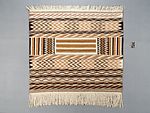swəw̓q̓ʷaʔɬ (Blanket)
About this object
History of use
The Musqueam, and other Coast Salish peoples, come from a long tradition of weaving. Although contemporary weavers weave for a variety of reasons, several of the weavers at Musqueam have expressed that their weaving enables them to connect with their ancestors and at the same time leave a cultural legacy for future generations. Many weave primarily for personal use and for gifts to family and friends, while others weave as a profession and sell their work to art dealers and museums. In recent years, Musqueam weavers have also received commissions from large corporations, such as Paramount Studios and the Vancouver Airport.
Narrative
Worn by Chief Joe Becker of Musqueam at the opening ceremonies for the new international wing of the Vancouver Airport on April 20, 1996; and by Musqueam elder, Vince Sparrow, at the Musqueam housepost unveiling ceremony at MOA on March 3, 1997. Chief Gail Sparrow also wore it at the opening ceremonies of the APEC Summit, which was held at MOA in November 1997. The weavers of this blanket noted that they made it as a "sister" to an old one in the collections of the Smithsonian Institute in Washington (#2124-0), since the original couldn't be brought home. The Smithsonian blanket was collected in the Lower Fraser area, and is typical of what has been called the "classic" period of Salish weaving. Robyn and Debra noted that they chose to reproduce this blanket "because it had some beautiful designs that we weren't sure how to do. So we wanted a challenge." [For a photograph of the old Smithsonian blanket, see "S'abadeb - The Gifts: Pacific Coast Salish Art and Artists," Seattle Art Museum, 2008, page 240.]
Cultural context
contemporary art
Specific techniques
Natural dyes and natural coloured wool used. The rust colour was obtained by dyeing grey wool with madder root. Debra and Robyn also used dandelions, stinging nettle, horsetail and tea for dyes during the period when this blanket was made. Wool spun on a spinning machine (s-spun). Photographs of the work in progress indicate that the weaving was reverse warped (a third bar was used). The zigzags were created using discontinuous warps and the weaving was done with double strand twining.
Physical description
Woven blanket made with s-spun wool. Dyed and naturally coloured wool used for wefts. Warp yarns are white, wefts are white, rust coloured, dark brown, and tan in colour. In general, the background colour is white and the weaving is done with double strand twining. The looped wefts at the top of the blanket are shorter than those at the bottom. The design features a series of horizontal stripes, bands with diagonal lines, wavy lines, and zigzags. The wavy lines are white on a brown background, all other designs are on white. The centre of the weaving has vertical stripes and zigzags bordering three sets of horizontal tan coloured lines edged with dark brown, and with a dark brown stripe in their centre. White stripes alternate with the tan ones. The designs beneath this section differ slightly.
Categories
Materials
